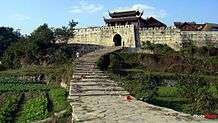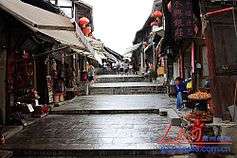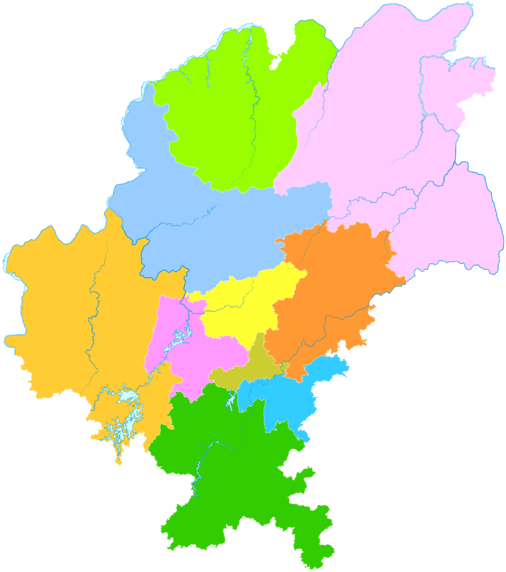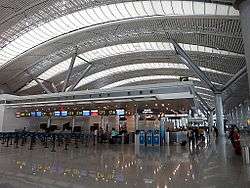Guiyang
Guiyang is the capital of Guizhou province of Southwest China. It is located in the center of the province, situated on the east of the Yunnan–Guizhou Plateau, and on the north bank of the Nanming River, a branch of the Wu River. The city has an elevation of about 1,100 meters (3,600 ft). It has an area of 8,034 square kilometers (3,102 sq mi).[1] During the 2010 census, its population was 4,324,561, out of whom 3,037,159 lived in the 7 urban districts.[2]
History

Guiyang was a 7th-century military outpost under the Sui and Tang, when the area around it was known as Juzhou (矩州).[3] It grew into a city named Shunyuan (順元) under the Mongolian Yuan dynasty sometime between their 1279 southwestern campaigns and 1283. By the time Guizhou became a full province in 1413, its capital at Guiyang was also known as Guizhou.[4] It became a prefectural seat under the Ming and Qing.[5] Guiyang grew rapidly during the development of the southwest that occurred after the Japanese invasion of China during World War II. It has also grown rapidly since Deng Xiaoping's economic reforms reached it in the 1990s.
Geography
The city's heart is around the Dashizi (大十字), a "big cross", and Penshuichi (喷水池, literally "Fountain Pool"), a traffic intersection, in the center of which there was a large fountain until early 2010, when it was paved over for better traffic.
Climate
Guiyang has a four-season, monsoon-influenced humid subtropical climate (Köppen: Cwa), tempered by its low latitude and high elevation. It has cool winters and moderate-temperature summers; the majority of the year's 1,118 millimetres (44.0 in) of precipitation occurs from May to July. The monthly 24-hour average temperature ranges from 5.1 °C (41.2 °F) in January to 23.9 °C (75.0 °F) in July, while the annual mean is 15.35 °C (59.6 °F). Rain is common throughout the year, with occasional flurries in winter. With monthly percent possible sunshine ranging from 12 percent in January to 41 percent in August, the city receives only 1150 hours of sunshine, making it one of China's least sunny major cities. Average monthly relative humidity is consistently above 75% throughout the year. The moderate temperature together with other factors including air quality, wind speed, etc. made Guiyang to be ranked No.2 in the "Top 10 Summer Capitals of China".[6]
| Climate data for Guiyang (1971–2000) | |||||||||||||
|---|---|---|---|---|---|---|---|---|---|---|---|---|---|
| Month | Jan | Feb | Mar | Apr | May | Jun | Jul | Aug | Sep | Oct | Nov | Dec | Year |
| Record high °C (°F) | 25.8 (78.4) |
29.7 (85.5) |
31.8 (89.2) |
35.3 (95.5) |
34.6 (94.3) |
35.6 (96.1) |
37.5 (99.5) |
35.9 (96.6) |
34.4 (93.9) |
32.1 (89.8) |
28.6 (83.5) |
26.1 (79) |
37.5 (99.5) |
| Average high °C (°F) | 8.8 (47.8) |
10.8 (51.4) |
16.1 (61) |
21.2 (70.2) |
24.1 (75.4) |
26.4 (79.5) |
28.3 (82.9) |
28.5 (83.3) |
25.1 (77.2) |
20.5 (68.9) |
15.9 (60.6) |
11.6 (52.9) |
19.8 (67.6) |
| Daily mean °C (°F) | 5.1 (41.2) |
6.6 (43.9) |
11.0 (51.8) |
16.1 (61) |
19.6 (67.3) |
22.2 (72) |
23.9 (75) |
23.6 (74.5) |
20.6 (69.1) |
16.3 (61.3) |
11.8 (53.2) |
7.4 (45.3) |
15.3 (59.5) |
| Average low °C (°F) | 2.7 (36.9) |
4.0 (39.2) |
7.8 (46) |
12.7 (54.9) |
16.3 (61.3) |
19.1 (66.4) |
20.7 (69.3) |
20.2 (68.4) |
17.4 (63.3) |
13.3 (55.9) |
9.0 (48.2) |
4.7 (40.5) |
12.3 (54.2) |
| Record low °C (°F) | −7.8 (18) |
−6.6 (20.1) |
−3.5 (25.7) |
0.1 (32.2) |
6.3 (43.3) |
10.4 (50.7) |
12.1 (53.8) |
13.1 (55.6) |
8.1 (46.6) |
3.3 (37.9) |
−2.4 (27.7) |
−6.6 (20.1) |
−7.8 (18) |
| Average precipitation mm (inches) | 20.5 (0.807) |
20.1 (0.791) |
32.8 (1.291) |
87.6 (3.449) |
164.6 (6.48) |
225.2 (8.866) |
177.0 (6.969) |
126.8 (4.992) |
100.1 (3.941) |
97.5 (3.839) |
47.4 (1.866) |
18.1 (0.713) |
1,117.7 (44.004) |
| Average precipitation days (≥ 0.1 mm) | 13.7 | 12.8 | 13.3 | 15.6 | 18.4 | 16.7 | 15.3 | 14.1 | 13.0 | 14.4 | 12.1 | 10.3 | 169.7 |
| Average relative humidity (%) | 80 | 78 | 76 | 75 | 76 | 78 | 77 | 76 | 76 | 77 | 77 | 76 | 76.8 |
| Mean monthly sunshine hours | 41.2 | 47.1 | 81.8 | 103.5 | 108.4 | 104.2 | 154.4 | 167.1 | 119.4 | 91.4 | 69.0 | 62.4 | 1,149.9 |
| Percent possible sunshine | 12 | 15 | 22 | 27 | 26 | 25 | 37 | 41 | 32 | 26 | 21 | 19 | 26 |
| Source: China Meteorological Administration | |||||||||||||
Administrative divisions
The entire Guiyang municipality currently consists of six districts, one county-level city and three counties. The districts are Nanming, Yunyan, Huaxi, Wudang, Baiyun and Guanshanhu. The county-city is Qingzhen and the counties are Kaiyang, Xifeng and Xiuwen.
| Map | ||||||||||||
|---|---|---|---|---|---|---|---|---|---|---|---|---|
| Division code[7] | English | Chinese | Pinyin | Area in km2[8] | Seat | Postal code | Subdivisions[9] | |||||
| Subdistricts | Towns | Townships | Ethnic townships | Residential communities | Villages | |||||||
| 520100 | Guiyang | 贵阳市 | Guìyáng Shì | 8034[10] | Guanshanhu District | 550000 | 49 | 29 | 48 | 18 | 460 | 1166 |
| 520102 | Nanming District | 南明区 | Nánmíng Qū | 209 | Xinhua Road Subdistrict (新华路街道) | 550000 | 15 | 4 | 1 | 139 | 29 | |
| 520103 | Yunyan District | 云岩区 | Yúnyán Qū | 94 | Guiwu Road Subdistrict (贵乌路街道) | 550000 | 18 | 1 | 134 | 19 | ||
| 520111 | Huaxi District | 花溪区 | Huāxī Qū | 958 | Guizhu Subdistrict (贵筑街道) | 550000 | 8 | 2 | 9 | 5 | 42 | 170 |
| 520112 | Wudang District | 乌当区 | Wūdāng Qū | 686 | Xintian Subdistrict (新天街道) | 550000 | 2 | 3 | 5 | 2 | 19 | 74 |
| 520113 | Baiyun District | 白云区 | Báiyún Qū | 260 | Dashandong Subdistrict (大山洞街道) | 550000 | 4 | 3 | 2 | 2 | 31 | 56 |
| 520115 | Guanshanhu District | 观山湖区 | Guānshānhú Qū | 307 | Jinyang Subdistrict (金阳街道) | 550000 | 1 | 2 | 1 | 16 | 33 | |
| 520121 | Kaiyang County | 开阳县 | Kāiyáng Xiàn | 2026 | Chengguan (城关镇) | 550300 | 6 | 10 | 3 | 13 | 108 | |
| 520122 | Xifeng County | 息烽县 | Xīfēng Xiàn | 1037 | Yongjing (永靖镇) | 551100 | 4 | 6 | 1 | 13 | 161 | |
| 520123 | Xiuwen County | 修文县 | Xiūwén Xiàn | 1076 | Longchang (龙场镇) | 550200 | 4 | 6 | 1 | 12 | 217 | |
| 520181 | Qingzhen | 清镇市 | Qīngzhèn Shì | 1381 | Hongfenghu (红枫湖镇) | 551400 | 1 | 4 | 5 | 3 | 41 | 299 |
Economy
- Guiyang's GDP: ¥ 249 billion (2014)
- Income per capita: ¥24,961 per year, per person (2014)
- Unemployment rate: less than 4%
Guiyang is the economic and commercial hub of Guizhou Province. The GDP per capita was ¥46,108 (US$7445) in 2013.[11] The city is also a large center for retail and wholesale commercial activities with operations of major domestic and international general retailers such as Wal-Mart, Carrefour, RT-Mart, Beijing Hualian (北京华联), Parkson, and Xingli Group (星力集团) as well as consumer electronics and appliance sellers Gome and Suning. Wholesale operations include large regional produce, furniture, and industrial and construction machinery depots. Wal-Mart's southwest China regional vegetable and produce distribution center is located in Guiyang. There are many foreign brands implanted in Guiyang, such as McDonald, Burger King, H&M, or Starbucks. Most of the time, they are located near the various shopping centers. The largest shopping centers are Hunter city plaza (亨特城市广场), Huaguoyuan Shopping Center (花果园购物中心), and Nanguohuajing (南国花锦).
Hydro-electric power generators are located along the city's main rivers including the Wu River. By 2007, the city's hydro electric plants supplied over 70 percent of the city's electricity. Coal is mined in the locality of Guiyang and Anshun, and there are large thermal generating plants at Guiyang and Duyun, supplying electricity for a portion of the city's industry. A large iron and steel plant came into production in Guiyang in 1960, supplying the local machinery-manufacturing industry.
Guiyang has a sizable domestic pharmaceuticals industry, producing traditional Chinese as well as Western medicines.
Demographics

Guiyang is populated by 23 different minorities, the most populous of which is the Miao people, in addition to the ethnic Han.
As of 2011, the total population of Guiyang municipality was 4.3 million, among which 2.9 million were urban residents.
Culture
Language
Guiyang’s language, belongs to the south-western Mandarin. It differs from the common Mandarin for the retroflex sounds it doesn’t have. Compared to mandarin that has 5 tones (four plus one that is not stressed), Guiyang’s local language only has 3 tones. Many old characters from ancient China still lives within Guiyang’s language, which sound like Koran or Japanese. For example, 去 sound as “ke”, fourth tone, means “go to”, instead of the Mandarin pronunciation “qù”.
Food
Provinces in China are known for the different specialities they offer, and Guiyang is most known for its spicy food (lajiao) as well as the following dishes:
- Gaoba porridge (糕粑稀饭; Gāobāxīfàn), a century old recipe, sweet desert.
- Fish in sour soup (酸汤鱼; Suāntāngyú), a Miao minority dish with roasted fish and various vegetables.
- Huangba (黄粑; Huángbā), a sweet wrap made of rice that can be steamed or fried
- Huaxi Vermicelli (花溪牛肉粉; Huāxī Niúròufěn), a dish that consists in vermicelli with beef, that is frequently eaten as a breakfast in Guiyang.
- Siwawa (丝娃娃; Sīwáwa), a Vegetarian dish with different kinds of vegetables accompanied with a dozen of wraps.
- Ice jelly with sesame seeds and peanuts (冰粉; Bīngfěn), usually eaten in summer, with Si Wawa or barbecue
- Intestines and blood noodles (肠旺面; Chángwàngmiàn), made up with pig’s intestines and pig's blood.
- Qingyan’s pig’s feet (青岩猪脚; Qīngyán Zhūjiǎo), mostly found in the old town of Qingyan, pig’s feet symbolize good luck.
 Qingyan Pig's feet
Qingyan Pig's feet Fish in sour soup
Fish in sour soup Siwawa
Siwawa
Tourism
Being the capital of Guizhou, a very old and traditional province of China, Guiyang is shaped by its history, and still possesses many historical sites that attract many tourists:
- The Jiaxiu Pavilion (甲秀楼; Jiǎxiù Lóu): The Jiaxiu Pavilion is located in the southern tip of the Guiyang Nanming River, which is the city’s emblem and its symbol. It was built during the Ming Dynasty and has more than 400 years of history.
- Qingyan Ancient Town (青岩古镇; Qīyán Gǔzhèn): Qingyan Ancient Town is located in the southern tip of Guiyang. It was originally built in the year 1378, during the Ming Dynasty. It is known its beautiful Chinese ancient architecture.
- Xifeng Concentration Camp (息烽集中营; Xīfēng Jízhōngyín): Xifeng Concentration Camp was the largest, highest-level prison of all the prisons set up by the Military commission of the KMT government during the Anti-Japanese war in 1937, and it was added by the state council to the list of major historical and cultural sites under state protection, in 1988.
- Confucian Center (孔学堂; Kǒngxuétáng): the Confucian center is a non-public and educational organization affiliated with the Ministry of Education of the People’s Republic of China. The Confucius Institute promotes and teaches Chinese culture and language around the world. The Confucian Temple, in the center of Qufu city, was built in 478 BC.
- Xifeng Hot Spring (息烽温泉; Xīfēng Wēnquán): Xifeng Hot Spring is located in the northeast of Xifeng County. The hot spring is surrounded by many mountains, upon which rich slopes grow a profusion of pines, firs, bamboos and other plants. This beautiful place has offered its advantages for sanatoriums, hospitals and villas.
- Qianling Park (黔灵公园; Qiánlín Gōngyuán): Qianling Park, in the northwest part of Guiyang, takes its name from Mount Qianling, which is known as southern Guizhou’s most majestic mountain. The park is covered with thick vegetation and old trees, with more than 1,500 types of flowers and trees, and at least 1,000 types of Medicinal herbs. The Hongfu Temple, built towards the end of the Ming dynasty and the beginning of the Qing Dynasty, is one of Guizhou’s most famous temples.
- Huaxi National Wetland Park (花溪湿地公园; Huāxī Shīdì Gōngyuán): Guiyang Huaxi national urban wetland Park is located in the north of downtown Guiyang’s Huaxi district. It is one of the only urban Wetland in the country. On the environmental aspect, it belongs to a subtropical humid climate of the plateau kanst hilly region, based on Karst landform characteristics of urban wetland park, its unique geographical location and geological structure form a rich variety of landscapes resources.
 Jiaxiu Pavilion
Jiaxiu Pavilion Qingyan Ancient Town
Qingyan Ancient Town Xifeng Concentration Camp
Xifeng Concentration Camp Qingyan Ancient Town
Qingyan Ancient Town
Lodging
- Hotels: Sheraton, howard Johnson, Plaza Hotel, Pullman International Hotel, Kempinski, Hyatt Hotel.
- Inns: 7 Days Group Holdings Limited, Jingjiang Inns, Theatre Time, Jinlusheng Food Square.
Nightlife
- Pubs & Bars
Most of the young people in Guiyang go out in the evening, after 10 pm. Their major activity is to go to bars, where they often indulge in drinking. The most dynamic street in Guiyang is Qianling Donglu (黔灵东路), ironically baptized Drinking Street, for the diversity and great numbers of pubs and bars that. In the province where Moutai comes from, an internationally well-known liquor, drinking tends to be a tradition. In Guiyang, beers are poured in small cups, and games – with dice or cards - are often necessary in order to drink.
- Night markets
When the night comes, street food flourishes everywhere in Guiyang, with its barbecue, grills and roasts. In Shaanxi Lu (陕西路), one can find mutton chops, baked snail, roast chicken. On Bo'ai Lu (博爱路) mutton patties, beef pounder, glutinous rice, noodle rice, combine western and eastern food. On Xiaoshizi (小十字), the crispy fried duck.
- Night gaming traditions
At night, the elderly usually prefer to indulge in outdoor games, games that are often quite ancient: Mahjong: a game made of bamboo, bone or plastics, each mahjone set consisting 136 tiles (about more than 3000 years old). Spinning top: A game mostly played by old men in public squares, that consists in whipping, with a cable, a kind of spinning top. Square dancing: middle aged ang elderly people dance in the square to relax or exercises anytime. (activities)
Transport
Transportation in Guiyang consists of an extensive network of roads, railways, river and air transport as well as public transportation system with bus system and many taxis. Guiyang Urban Rail Transit has been constructed since 2011. Based on the current planning, the whole network is formed by the 8 lines. Line 1 will be operational in 2016.
Air
Guiyang is one of the important air transport hubs in Southwest China. Guiyang's main airport is the Guiyang Longdongbao International Airport (KWE) opened on May 28, 1997. It is located in east of Guiyang, 11 km (6.8 mi) away from the city center. The airport is connected to national and international destinations, such as Hong Kong, Taipei, Seoul (Charter), Phuket (Charter), Singapore (Charter), Bangkok, Taichung & Taitung (Charter), Beijing, Shanghai, Guangzhou, Shenzhen, Chengdu. In 2010, the airport handled 6.2717 million passengers.
Railway
Guiyang is a railway hub in southwest China. The Guizhou–Guangxi Railway (built in 1959, modified 2009), the Sichuan–Guizhou Railway (completed 1965), the Guiyang–Kunming Railway (completed 1970), and the Hunan–Guizhou Railway (completed 1975) are intersecting in Guiyang Railway Station. This main southern railway station is being rebuilt in 2008.
The Guiyang–Guangzhou High-Speed Railway began operations on December 26, 2014. Three more high-speed rail lines to Chongqing and Kunming, and Changsha will commence operations within the next few years. The high speed railway lines will provide rapid freight service from two rail yards, and passenger service from a new high-speed railway station, called Guiyang North Railway Station, in the city's Guanshanhu District.
Expressway
The city is located at the junction of four major segments of the national highway grid: the Gui–Huang, Gui–Zun, Gui–Bi, and Gui–Xin Expressways. The Gui-Huang Expressway (G60) links Guiyang with the cities and tourist areas of central and western Guizhou including Anshun, Guanling, and the Huangguoshu Waterfall. The expressway continues west to Yunnan Province as the Gui-Kun Expressway and terminates at Yunnan's capital city of Kunming. G75 Lanzhou–Haikou Expressway runs north 180 km (110 mi) to Zunyi and is the most heavily travelled major highway in Guiyang. In Zunyi, the expressway becomes the Zunyi-Chongqing Expressway and runs a further 210 km (130 mi) north to Chongqing. G76 Xiamen–Chengdu Expressway links Guiyang with the regional cities of Bijie and Dafang in northwest Guizhou province, southeastern Sichuan province, and the Sichuan cities of Luzhou, Neijiang, and Chengdu—Sichuan's provincial capital. The Gui–Bi Expressway begins at an interchange with the Gui–Zun Expressway in the city's Xiuwen County approximately 20 km (12 mi) north of the city center, before terminating at the city of Bijie. In the city of Dafang, approximately 40 km (25 mi) east of Bijie, the Gui–Bi Expressway connects with the new Sichuan–Guizhou Expressway, a modern highway providing access to Luzhou and central Sichuan. The Gui–Xin Expressway begins at the junction of the Guiyang Outer Ring Road (G75, G60.01) and the Tang Ba Guan Road, approximately 5 km (3.1 mi) southeast of the city center. The Gui–Xin Expressway (G60, G75) runs east and southeast through the Guangxi Zhuang Autonomous Region (G76), passing through Guilin, before entering Guangdong, and terminating at Guangzhou. Approximately 170 km (110 mi) east of Guiyang in the regional city of Kaili, the Hunan-Guizhou Expressway (G56, G60) links with the Gui–Xin Expressway providing high-speed vehicular access to and from Guiyang to the eastern Guizhou city of Tongren before continuing through Hunan to the major cities of Huaihua, Changde, and Changsha. The China National Highway 210 also runs through Guiyang via Xifeng and Longli.
In 2009 Guiyang added a modern orbital expressway to its highway network. The Guiyang Outer Ring Road (Guiyang Orbital Highway) opened in December 2009 and is a six- to eight-lane divided high-speed expressway that provides efficient links to and from large employment centers in the Jinyang New District, Baiyun District, Huaxi District, the Guiyang Longdongbao International Airport, the major multi-lane national highways, and the city's main roadways, allowing vehicular traffic to circumnavigate the heavy traffic of the city's inner city areas.
| Transportation infrastructure of Guiyang | ||||
|---|---|---|---|---|
|
Education
The city has a university, a teacher-training college, and a medical school. In addition, there are 224 primary and middle schools.
- Guizhou University 贵州大学
- Guizhou Normal University 贵州师范大学
- Guizhou Medical university贵州医科大学
- Guizhou University of Finance and Economics 贵州财经大学
- Guizhou Nationalities University 贵州民族大学
- Guiyang College 贵阳学院
- Institute Of Geochemistry, Chinese Academy of Sciences 贵州科学院
- Guiyang College of Traditional Chinese Medicine 贵阳中医学院
- Commercial College of Guizhou 贵州商学院
Religion
On October 15, 1696, the city was made the seat of the Roman Catholic Apostolic Vicariate of Kweichow. This was suppressed in 1715 and restored in 1846. In 1924 it was renamed as the Apostolic Vicariate of Guiyang, and in 1946 it was promoted to its current status as the Roman Catholic Archdiocese of Guiyang.
See also
References
- ↑ (simplified Chinese) "Profile of Guiyang". www.xzqh.org. Archived from the original on 2008-05-07.
- ↑ http://www.geohive.com/cntry/cn-52.aspx Statistics of China 2010 Census
- ↑ Wilkinson (2012), p. 233.
- ↑ Wilkinson, Endymion (2012). Chinese History: A New Manual. Harvard-Yenching Institute Monograph Series 84. Cambridge, MA: Harvard-Yenching Institute; Harvard University Asia Center. p. 233. ISBN 978-0-674-06715-8.
- ↑ "Guiyang", Britannica Concise Encyclopaedia, 2006, p. 816.
- ↑ http://travel.sohu.com/20130709/n381114842.shtml
- ↑ 国家统计局统计用区划代码
- ↑ 《贵阳统计年鉴2011》
- ↑ 《中国民政统计年鉴2011》
- ↑ 国土资源局数字为8046.67平方公里
- ↑ http://www.elivecity.cn/html/jingjifz/2325.html
External links
| Wikimedia Commons has media related to Guiyang. |
 Guiyang travel guide from Wikivoyage
Guiyang travel guide from Wikivoyage- (simplified Chinese) Guiyang Government website
- (English) Guiyang Government website
- (English) Photos of Guiyang

.png)

.svg.png)



